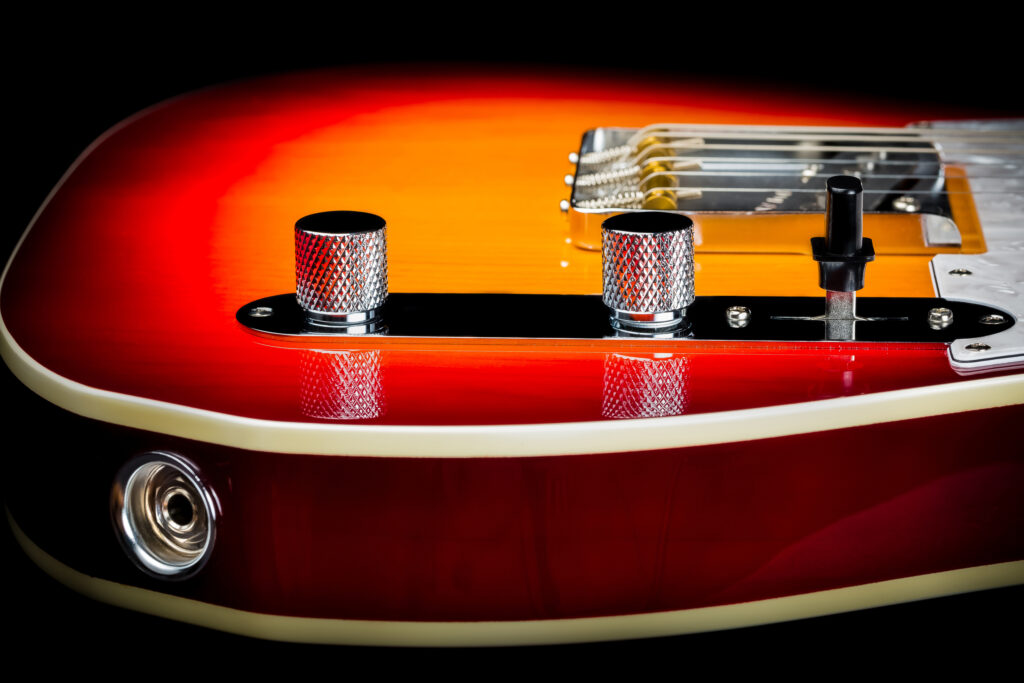
Today on the GAK Blog, we’re taking you through our Top 10 Telecaster Players at GAK. Each of the artists mentioned in our list has wielded the legendary Fender electric guitar to excellent effect. Please note, this list is in no particular order!
The artists we’ve included range from rock legends to country pickers to metal mavericks, showcasing the Telecaster’s versatility.
Many of the guitarists in this Top 10 list have a strong association with a specific Telecaster. Jeff Buckley’s “Hallelujah” Telecaster, Keith Richard’s “Macawber” and Jonny Greenwood’s mid-nineties Telecaster Plus are just a few examples.
These unique, one-of-a-kind guitars become more than wire and wood. They’ve become essential tools that helped to shape music and inspire generations of musicians for years to come.
Let’s Dive In
The Telecaster has been the guitar of choice for countless guitar legends over the years. From the pristine twang of country music to blistering rock riffs, the Telecaster’s distinct voice has echoed through so many genre-defining tracks and landmark performances.
So, whether you’re a seasoned guitarist, a curious beginner or a music enthusiast, sit back, read on and join us on this journey into the Tele. Discover how these musicians and their trusty Telecasters have gifted us with truly incredible music, forever cementing its status as a guitar for the ages.
Skip Ahead
The Legendary Telecaster
#10 – Jeff Buckley
#9 – Andy Summers
#8 – Prince
#7 – Tom Morello
#6 – Albert Collins
#5 – John 5
#4 – Bruce Springsteen
#3 – Danny Gatton
#2 – Keith Richards
#1 – Jonny Greenwood
Closing Thoughts
The Legendary Telecaster
In the annals of guitar history, few models are as revered, influential and iconic as the Fender Telecaster. Born in early 1951, the Telecaster – affectionately known as the “Tele” – made a major mark on the music industry.
The first mass-produced solidbody electric guitar, the Telecaster offered guitarists an easy-playing, reliable and affordable instrument. It could go from a bright, cutting tone to a warm and delicate one in an instant. Thanks to its working musician-focussed design, the Tele achieved immense success.
In the decades since its creation, the Telecaster has remained largely unchanged – a testament to the timelessness of its design.
Jump Back to the Start
#10 – Jeff Buckley
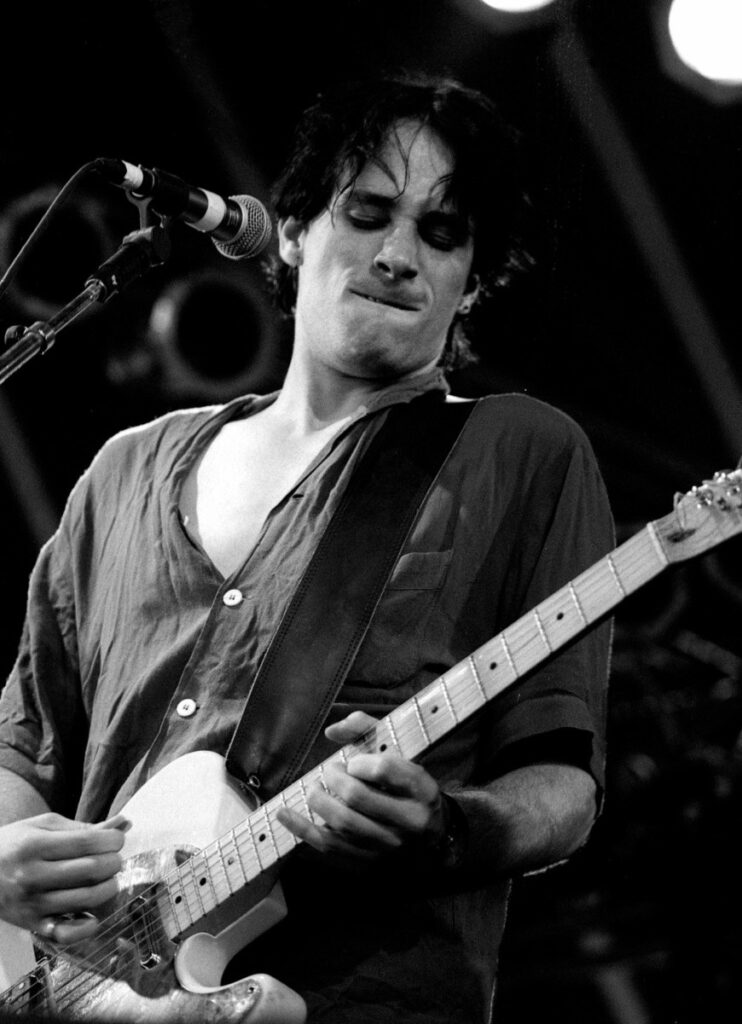
Revered singer, songwriter, and guitarist Jeff Buckley holds the #10 position on our list of Top 10 Telecaster Players at GAK. Whilst Buckley is most well-known for his electrifying vocal, moving songs and tragic passing, he was also an adept guitarist.
The guitar most associated with Jeff Buckley is a blonde 1983 Fender Telecaster with a mirrored scratchplate. It accompanied him throughout his short but significant career, including his early performances at the Sin-é cafe, his debut album Grace and the music video for “Hallelujah”.
Jeff’s Jazz Fusion Days
Initially, Buckley had no aspirations of becoming a singer-songwriter like his father Tim Buckley, also a genre-defying artist with jaw-dropping vocal dexterity. Instead, he wanted to be a lead guitarist like his hero Jimmy Page.
As a graduate of California’s Guitar Institute of Technology, Jeff Buckley followed in the footsteps of famous alumni such as Frank Gambale and Paul Gilbert. He was a technically proficient player, able to perform Rush, Yes and fusion guitarist Al Di Meola songs effortlessly.
Transcending Shred
You won’t hear flashy solos, sweep picking or tapping in Jeff Buckley’s music. Rather, Jeff Buckley subtly demonstrates his mastery of the guitar through his intricate and inventive chord voicings, a seamless fusion of multiple styles and his ability to convey emotion through his playing.
Buckley’s proficiency with the guitar was especially evident in his command over complex chordal work. You can hear it in the diminished intervals in his rendition of “Hallelujah”, the jazz chords in “Lover, You Should’ve Come Over” and the cycling arpeggios in “Dream Brother”.
Jeff Buckley’s approach to playing was as diverse and distinctive as the Telecaster itself. His unique sound, a rich combination of rock, folk, soul, blues and jazz, broke free from conventional boundaries. His faithful blonde Tele was able to handle Buckley’s eclectic style with ease.
The Hallelujah Telecaster
A chance meeting with Janine Nichols at his father’s tribute concert “Greetings From Tim Buckley” in 1991 sparked Buckley’s relationship with the Telecaster.
Left without a guitar after a theft, Nichols lent Buckley her 1983 Telecaster. Nichols had personalised with a mirror pickguard, influenced by Chrissie Hynde of The Pretenders. The distinctive six-saddle, top-loading bridge and slightly out-of-phase neck pickup contribute to this Tele’s unique tone.
Further Tweaks
Buckley would later add his own modifications. He would refret the guitar with Jumbo frets and replace the bridge pickup with a Seymour Duncan Hot Lead Stack, a single-coil-sized humbucker with tonnes of punch.
Buckley demonstrated that even a humble Telecaster from this CBS-owned era could become a conduit for musical magic in the right hands. This ’83 Telecaster, later known as the “Hallelujah” Telecaster, became Buckley’s primary instrument, accompanying him on stage and in the studio.
Zeppelin, Elvis and Beyond
In Buckley’s own words, the Telecaster represented “Led Zeppelin I, Elvis, [and] country”, encapsulating a range of musical influences and styles.
His affinity for the Telecaster underscores its versatility and timeless appeal. Through his innovative approach and effortless musicality, the Telecaster was more than an instrument—it was a crucial element of his artistic voice.
Matt Bellamy of Muse is currently the proud owner of the “Hallelujah” Telecaster. Bellamy bought the guitar in May 2020 from Matt’s Guitar Shop in France. He’s since used it on Muse recordings, giving the hallowed Telecaster a new lease of life.
Jump Back to the Start
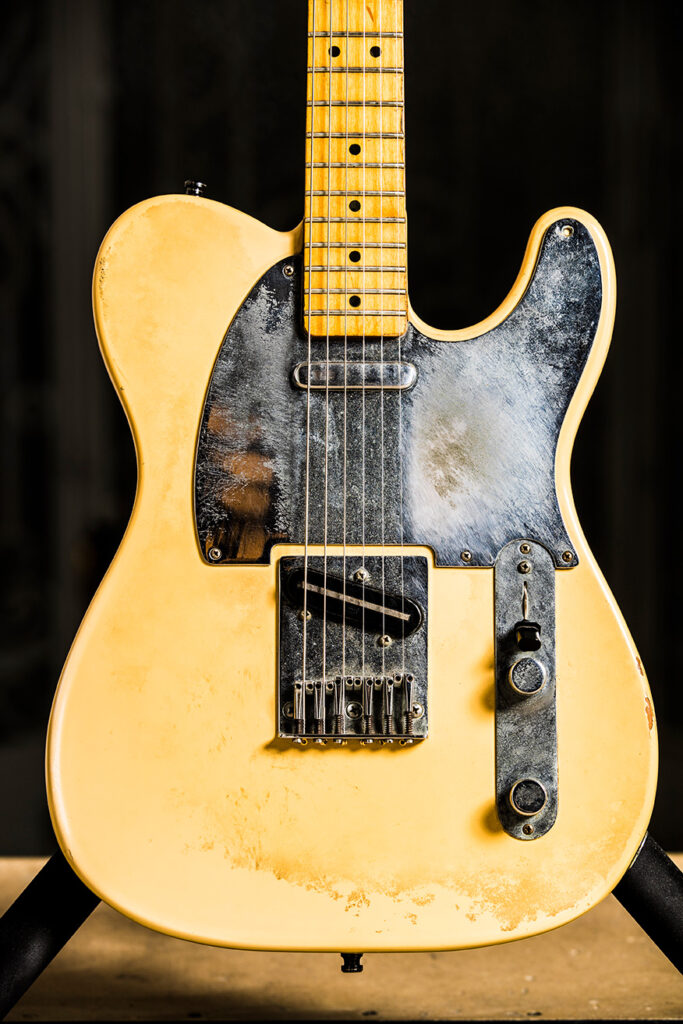
#9 – Andy Summers
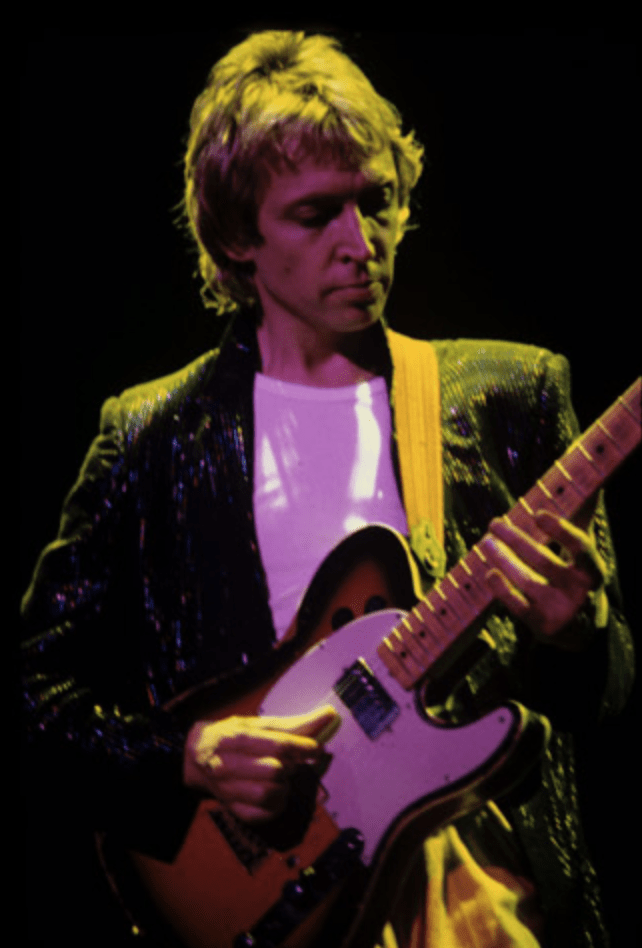
As the guitarist of the legendary multi-platinum-selling rock band The Police, Andy Summers secures the #9 spot on our list of Top 10 Telecaster Players at GAK.
While The Police are widely recognized for their infectious reggae-infused punk rock anthems, Summers’ distinct guitar work was a key component of their sound.
The Telecaster associated with Summers is a modified 1961 Fender Telecaster. Summer bought this Tele as a beat-up second-hand instrument for just $200. It was previously owned by a student he taught classic guitar to during his college years in Southern California.
It became his trusty sidekick throughout his illustrious career. This Tele would feature on tracks such as “Roxanne,” “So Lonely,” “Walking On the Moon,” “Message In a Bottle,” and “Every Breath You Take” among Police hits.
Early Days and Musical Influences
Even before The Police released their debut LP, Outlandos D’Amour, in 1978, Summers was a seasoned guitar player. He had his beginnings as a teenager in the ’60s, playing with Zoot Money’s Big Roll Band and rubbing shoulders with giants of the era like Jimi Hendrix and Pink Floyd.
Summers describes himself as an improviser, with a background steeped in jazz rather than pop music. His influences ranged from Wes Montgomery and Kenny Burrell to Miles Davis and Charles Mingus.
This rich musical heritage contributed to his sophisticated chord voicings, clever lead salvos, percussive rhythm work, and inventive use of effects. His echo/chorus combo became a defining guitar sound of the era.
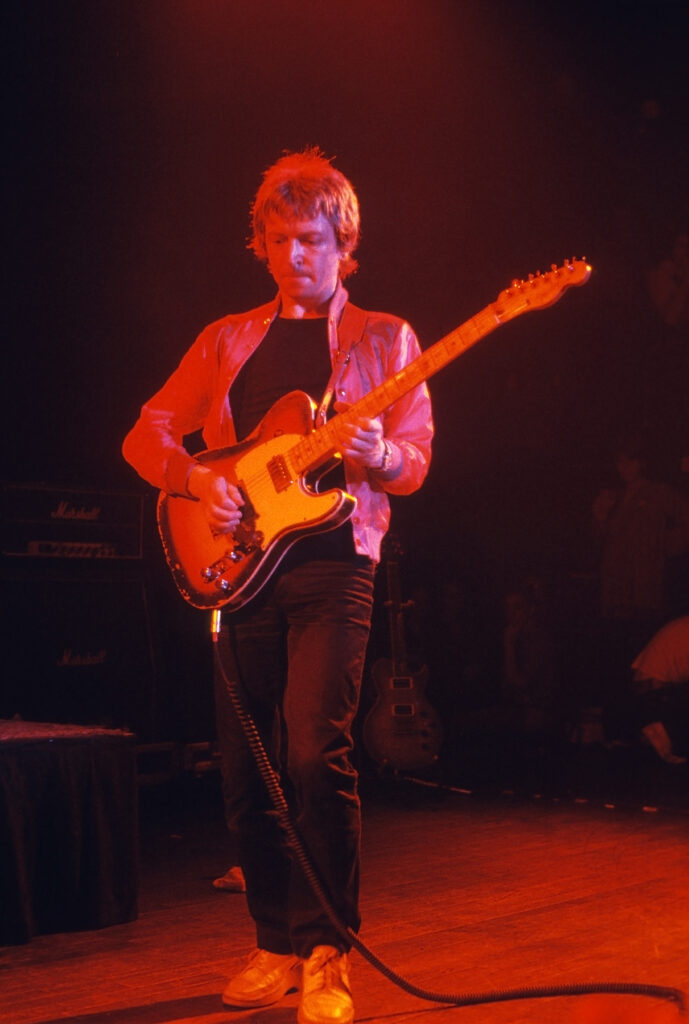
Not Your Average Tele
While struggling on a meagre income as a student in Los Angeles, Summers acquired the beat-up 1961 Fender Telecaster from one of his guitar students.
Despite its worn-out appearance, the guitar had a certain allure that immediately captivated Summers. He described a profound connection with the instrument the moment he started playing it. This modified 60s Telecaster would become an integral part of Summers’ musical journey.
The Fender Custom Shop would later make a short run of guitars that replicated every detail of Summers’ one-of-a-kind Tele.
“When I start to play it, something stirs within me … it shakes me … I find that I can’t stop playing it; this guitar sparks something in me and I have to have it”.
Special Modifications
Summers’ unconventional Telecaster is more of a hybrid. When he bought it, it was equipped with various modifications like a Gibson humbucker in the neck position and added switches for overdrive and out-of-phase settings.
These alterations gave his Telecaster additional tones that transcended the bright, twangy sound typically associated with Telecasters.
Summers’ distinctive Telecaster is a testament to the versatility of the guitar and its ability to go beyond its Western swing, country and rock ‘n’ roll roots. His innovative approach to the guitar demonstrated that, in the right hands, the Telecaster is a powerful tool that can shape a band’s sound.
This humble instrument, bought for just $200, helped The Police become a global smash and would become an iconic instrument in its own right.
“It wasn’t just any Telecaster, it was an exceptional one. Just one of those guitars that had the magic, with the incredible electric tone”.
Jump Back to the Start
#8 – Prince
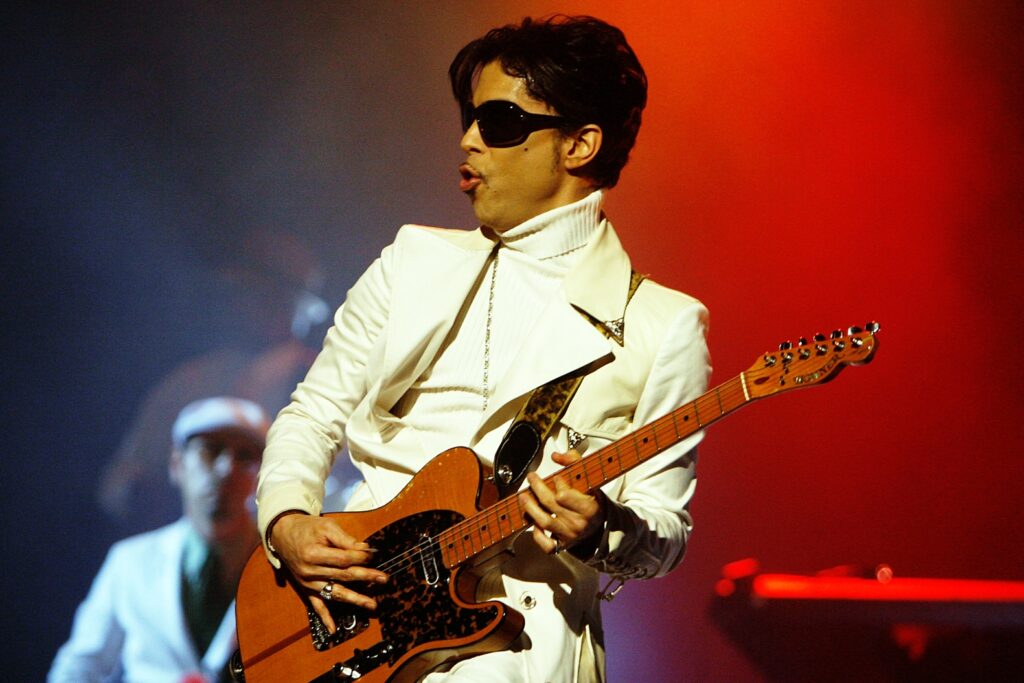
The eighth spot on our list of Top 10 Telecaster Players at GAK is occupied by the legendary artist, Prince. Known as the prodigy of pop/funk, Prince’s extraordinary body of work serves as a testament to his exceptional songwriting prowess, musicality, and virtuosic guitar skills.
The guitar most commonly associated with Prince is not a standard Telecaster, but the Hohner Madcat. This T-style guitar shares elements of both the Fender Telecaster and the Stratocaster.
This guitar became Prince’s faithful companion across numerous tours and albums, starting with the Dirty Mind tour and extending to the Welcome 2 America tour.
Ascent to Stardom
Raised in a city renowned for its vibrant music scene, Prince began his ascent to stardom in his native Minneapolis. Even at the young age of 18, when he recorded his debut album For You playing all the instruments himself, Prince was already recognized as a prodigious musical force.
His influences were diverse, incorporating elements of funk, hard rock, and psychedelic music. He was often compared to Jimi Hendrix and James Brown for his unparalleled guitar skills and dynamic showmanship.
His insatiable work ethic and unwavering drive to push those around him to their utmost abilities manifested led to the founding of Paisley Park, his Minneapolis-based headquarters.
The unique guitar work featured in Prince’s 40 studio albums, including the genre-bending Alphabet Street and the emotionally charged Purple Rain, is a testament to his incredible technical proficiency and creative inventiveness.
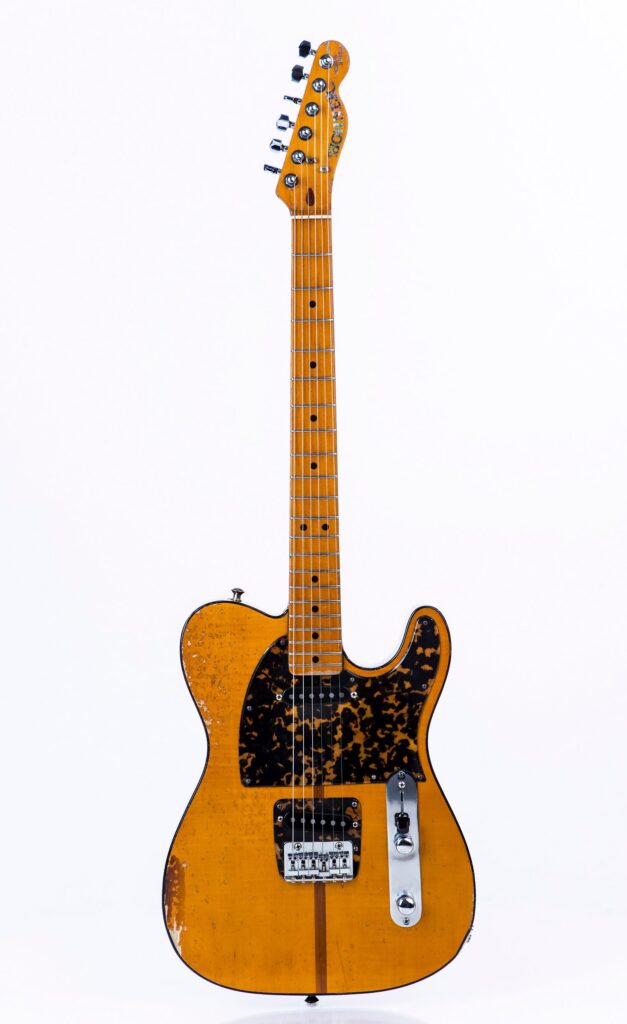
The Iconic Madcat
The Hohner Madcat, with its distinctive design and unique sound, is the guitar most associated with Prince. Originally released as the H.S. Anderson Madcat by the Japanese Morris Guitar company, it was later released under the Hohner brand. Allegedly, only around 500 of these guitars were ever made.
Whilst the Madcat shares a lot of qualities with the Telecaster, it isn’t a straight copy of the classic Fender guitar. It features a walnut centre strip, sen (an Asian tonewood that’s similar to ash) sides and a book-matched tiger maple top and back.
The guitar’s pickguard is reminiscent of leopard print. It’s said that this is one of the reasons why Prince chose the Hohner Madcat, as it matched his stage costume and fake fur-covered equipment at the time.
Its bridge was similar to a hardtail Stratocaster, and it featured pickups akin to the neck and bridge pickups from the Strat. The result is a guitar with a single-cut, Tele-style look and a crisp, Strat-flavoured tone.
A Beast from the Far East
Prince acquired his Hohner Madcat in the late 1970s. Some say that Prince bought it at a petrol station for only $30. Former Prince bassist Andre Cymone claimed that it was bought from a Minneapolis guitar store that he and Prince used to frequent. It’s also
Although the Madcat was a lot more affordable than a US-made Fender Telecaster at the time, there’s no doubting its quality and performance. This is owed to it being built by the equivalent of the Morris factory’s custom shop team.
The Madcat was one of Prince’s go-to guitars so it was meticulously maintained to keep it roadworthy. Takumi Suetsugu, Prince’s long-time guitar tech, claimed it was the best Telecaster he’d ever played.
Over time, modifications were made, including replacing the pickups (first with Fender Vintage Noiseless and later Kinman Traditional pickups) and adding a wireless receiver into the body during the Purple Rain tour.
Rock, Funk and Beyond
Prince’s approach to the electric guitar was as eclectic and exciting as his music. His exceptional skills as a songwriter, producer and multi-instrumentalist often overshadowed his phenomenal guitar-playing abilities.
However, any dedicated fan or fellow musician knows the prowess that Prince held with a six-string in his hands.
Prince’s playing was deeply expressive, highly technical, and daringly experimental. He incorporated various techniques, ranging from complex chords, lightning-fast single note runs, Hendrix-like heavy rock riffs, flamboyant blues solos, and nuanced, soulful melodies that could bring an audience to tears.
His improvisational skills were legendary, as evidenced by his notorious late-night jam sessions and iconic performance at the Rock and Roll Hall of Fame, where he performed a jaw-dropping solo on “While My Guitar Gently Weeps”.
He was a master of funk rhythm guitar, deploying complex, syncopated riffs with an impeccable sense of groove, very much in the vein of his friend, Nile Rodgers. His ability to blend these various styles and techniques into a seamless, compelling narrative within a song was nothing short of genius.
#7 – Tom Morello
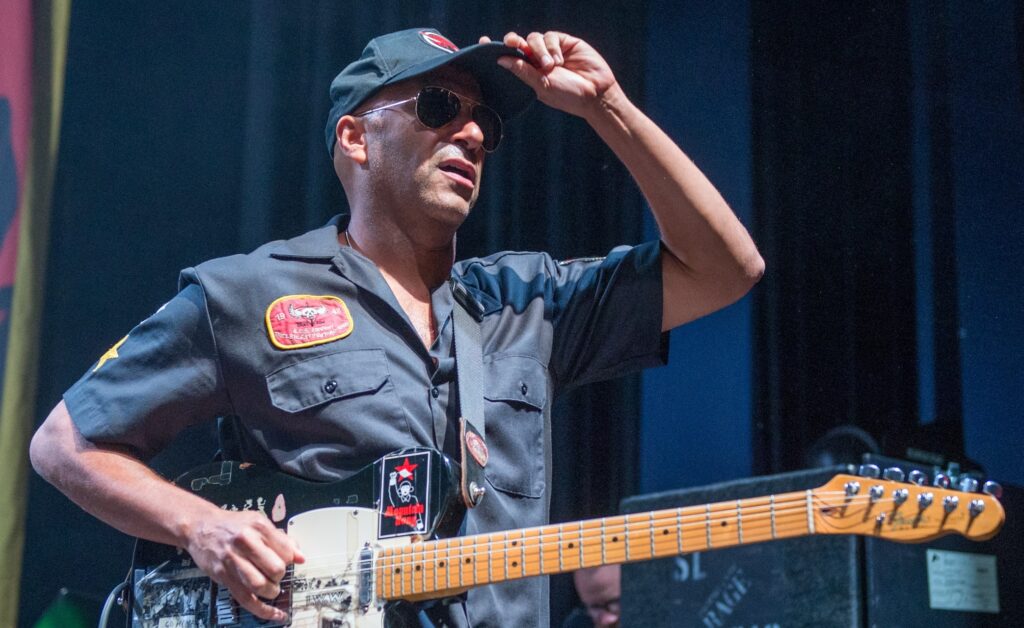
At #7 on our Top 10 Telecaster Players at GAK list is mind-bending genius Tom Morello of Rage Against The Machine and Audioslave fame. He’s known for his heavy yet groovy riffs, his ability to conjure a huge range of sonic textures from a relatively sparse set of effects pedals and his astounding virtuosity.
This all comes from a melting pot of influences, including a lesson with shred master Michael Angelo Batio, rock guitarists such as Tony Iommi of Black Sabbath and Jimmy Page of Led Zeppelin and groundbreaking hip-hop artists like Run-DMC and Public Enemy.
While Morello’s inspirations are as diverse as they come, his singular style has led to his recognition as the fifth-greatest guitarist of the past 30 years in 2010. He views himself as “the DJ in the band”, sometimes mimicking a turntablist on tracks like “Bulls On Parade”.
Study By Day, Shred At Night
Born in Harlem, NYC and raised in Libertyville, Illinois, Morello experienced a unique upbringing. His mother was an activist and teacher at his high school, and his father was Kenya’s first ambassador to the United Nations. Music, particularly rock, was a vital part of Morello’s youth.
He went from playing covers in his first band, Nebula, to writing his own politically-charged music influenced by Run-DMC and DJ Jam Master Jay.
During his time at Yale University, Morello dedicated himself to both academic and musical pursuits, often practising guitar for up to eight hours a day. Following his graduation, he moved to Los Angeles to pursue a career in music.
Through his numerous projects, including Rage Against The Machine, Audioslave, Prophets of Rage, and his solo projects as The Nightwatchman, Morello has continually reinvented the rules of guitar playing. His singular and inventive approach has had a massive influence on electric guitar players.
“My guitar playing is solely a product of my determination to explore, rather than any sort of great mastery of technique. A lot of noises I make on the guitar you can make very easily. You just have to think”.
Tom’s Telecaster
Tom Morello’s 1982 American-made Standard Telecaster, known as “Sendero Luminoso” (Spanish for “Shining Path” and the name of Peru’s Marxist-Leninist-Maoist guerilla group), has been the weapon of choice for many of his iconic riffs. As Morello’s main Drop D guitar, this Fender Tele has featured on staple RATM tracks such as “Killing In The Name”, “Freedom” and “Testify”.
Aside from visual appointments such as the various images taped onto its body (including a red hammer and sickle communist party sticker) and the “Sendero Luminoso” etching, Morello’s Telecaster is stock. In typical Morello style, he mainly uses the Tele’s neck single-coil.
“To me, it always sounded right to my ears, and sometimes I think the heaviness of the riff hasn’t got anything to do with the amount of distortion on the guitar. There are plenty of bands and albums that are distorted out the ass and I just feel [they’re] not moving at all in a way that is compelling”.
Before going on tour around the world with Tom Morello, this Telecaster belonged to his late roommate Scott Tracey.
Morello wanted an electric guitar for Drop D tuning after being shown it by Maynard James Keenan of Tool. He couldn’t do it on his standard tuned guitar “Arm The Homeless” due to its double-locking system. Morello would swap one of his spare Marshall heads for the Fender Telecaster.
“[Scott Tracey] never got to tour so this tours for him everywhere.”
Jump Back to the Start
#6 – Albert Collins
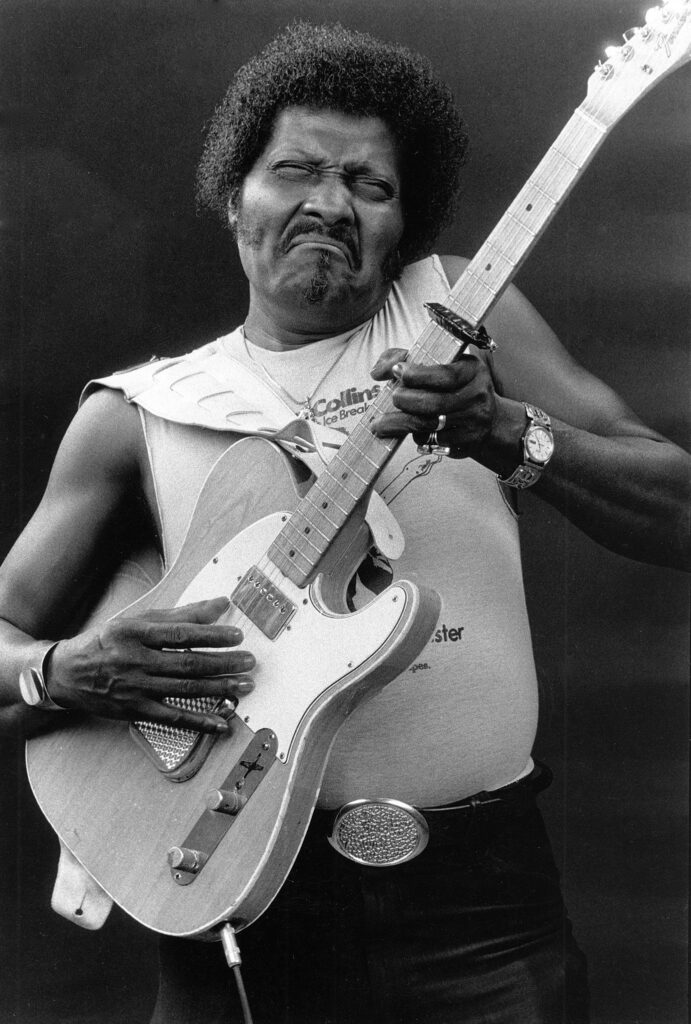
Albert Collins, an iconic bluesman, secures the #6 spot on our list of Top 10 Telecaster Players at GAK. Known as the “Master of the Telecaster” and “The Iceman”, Collins’s unique approach to blues guitar was characterized by his biting tone, a trademark he developed using his Telecaster.
A 1966 Fender Telecaster Custom was the weapon of choice for Collins throughout his prolific career. This Tele was combined with a cranked 4×12 Fender combo amplifier and an extremely long 100ft guitar cable that allowed him to freely roam during performances.
Collins’ use of such a long guitar lead became a part of his mythology. Legend says that he could leave the venue to order pizza mid-show without missing a beat!
A Blues Prodigy Emerges
Born in Texas in 1932 as Albert Drewery, Albert Collins began his musical journey experimenting with jazz piano before receiving his first guitar at age 10 from blues legend Lightnin’ Hopkins. He’d later be taught how to play by his cousin Willie Young, before forming his group, the Rhythm Rockers, at 18.
It was Young who showed Collins the unconventional Open F Minor tuning (low-to-high: FCFAbCF) that he’d become known for using. Collins would use a capo to adjust his guitar to the key of the song. Open F Minor is known as a “cross-note” tuning, as it allows you to easily switch from major to minor.
Albert Collins drew inspiration from the likes of renowned blues guitarists such as John Lee Hooker, Guitar Slim, T-Bone Walker, and BB King. Over time, Collins would develop the expressive, bend-heavy style that would become his signature.
Initially, Collins played an Epiphone. He was later swayed to switch brands after witnessing Clarence Gatemouth Brown perform with a Fender Esquire.
This led him to his primary weapon, a 1966 Fender Telecaster Custom. This particular Tele features an ash body, maple fretboard, ashtray bridge, and Gibson humbucker in the neck.
Classic Collins Tracks
If you’re new to Albert Collins and want to experience his singular sound, listen to his tracks like “Frosty” and “I Ain’t Drunk”, the melancholic 12-bar “Dyin’ Flu”, or his Grammy-winning album “Showdown”, made in collaboration with blues giants Robert Cray and Johnny Copeland.
Collins’ raw, piercing Telecaster tones and inventive playing approach would help him become one of the most influential electric blues guitarists of all time.
Crafting the “Iceman” Tone
While Collins could extract a throaty warmth from the neck pickup, most of his sound came from his favoured bridge pickup. His idiosyncratic open F minor tuning (low to high: F C F Ab C F) allowed for unique note choices beyond the orthodox blues scale shape.
His playing was filled with emotion and taste, characterized by dramatic bends, intense vibrato, slurs, slides and rapid hammer-ons and pull-off licks. Rejecting the use of a pick, Collins played his Tele with his fingers, primarily using his thumb and forefinger.
A signature move was his “double octave” technique. He would hit the low E string with his thumb for the tonic note and immediately follow it with the same note two octaves higher on the second string, using his forefinger.
The Iceman’s Legacy
Albert Collins’s unique approach, from his fingerpicking style to his open F minor tuning, was faithfully conveyed by his trademark Telecaster Custom. There’s no question that Collins left an indelible mark on the world of blues and forged his name in the annals of the genre’s most renowned players.
A trailblazer, Collins showcased how a Telecaster could become a vehicle for groove, taste and expression in the right hands. There’s a reason he’s known as the “Master of the Telecaster”! To this day, Albert Collins continues to influence and inspire generations of blues guitarists.
Jump Back to the Start
#5 – John 5

John William Lowery, known as John 5, fittingly occupies the #5 position on our list of Top 10 Telecaster Players at GAK. Known for his distinctive lead style that seamlessly fuses metal and country, John 5’s mastery of the Telecaster transcends conventional musical boundaries.
John 5’s career spans over three decades. His journey from a teenager obsessed with guitars to one of the most in-demand guitar players around is thanks to his unyielding passion and dedication.
A Love Affair with the Telecaster
For many, a Telecaster might seem like an unconventional choice for a genre dominated by humbuckers and aggressive aesthetics. However, for John 5, the Telecaster wasn’t just another guitar; it was the guitar.
John 5’s relationship with the Telecaster began in his youth. His first proper guitar was a ’75 Stratocaster. In fact, he even met the iconic Stevie Ray Vaughan and had him sign it. But his heart was always set on a Telecaster, and he finally got one at 15. It was a love affair that only deepened over time.
He fell in love with the guitar watching “Hee Haw”, a US comedy and country music show, with his Dad. During his childhood, he believed that Telecasters were the only electric guitars in existence. Even as he learned about other guitars, in John’s eyes, the Telecaster remains unparalleled.
“I’m a Telecaster connoisseur, and I love my Teles. I have one from almost every year since the very beginning, in 1950. I’m so obsessed with them. I just really enjoy the history of Fender—the story of Fender and how it all came about. I have a collector’s soul.”
A Technique That’s All His Own
Though many metal aficionados recognize him from his performances alongside Rob Zombie, guitar enthusiasts understand the breadth of John 5’s proficiency and skill. John 5’s technique transcends traditional shredding. It’s an approach that blends an array of styles, each executed with perfection.
His influences stretch from country, bluegrass, western swing to jazz and flamenco. His ability to shift seamlessly between genres, whether it’s executing hyperspeed chicken-pickin lines or replicating cascading banjo rolls, showcases his jaw-dropping ability with the electric guitar.
Over the past 30 years, John 5’s contribution to the music industry has been immense. Beyond being a stage performer, he’s also a sought-after songwriter, session guitarist and solo artist.
With collaborations with artists like Rob Halford, KD Lang, Rod Stewart, David Lee Roth and Alice Cooper, John 5’s resume is as eclectic as his playing style. As of August 2023, he’s the live guitarist for legendary glam metal band Mötley Crüe, after the retirement of founding guitarist Mick Mars.
“I appreciate anything that’s done well. If I hear a bluegrass player killin’ it, I’m like, ‘I have to play that!’ And if I hear a metal player rippin’ it, my brain just fries. So I have to learn what they’re doing and execute it perfectly. I obsess over it, and I love it dearly.”
Twang and Beyond
John 5’s connection to the Telecaster and his unique technique embodies the spirit of musical exploration. His commitment to his craft and the Telecaster is a testament to the infinite possibilities that lie within the strings of this iconic instrument.
John’s approach to playing, like the Telecaster itself, breaks free from conventional boundaries. With each chord and solo, he reaffirms why he’s one of the most mind-blowing guitarists around, carving a niche that’s all his own.
Jump Back to the Start
#4 – Bruce Springsteen
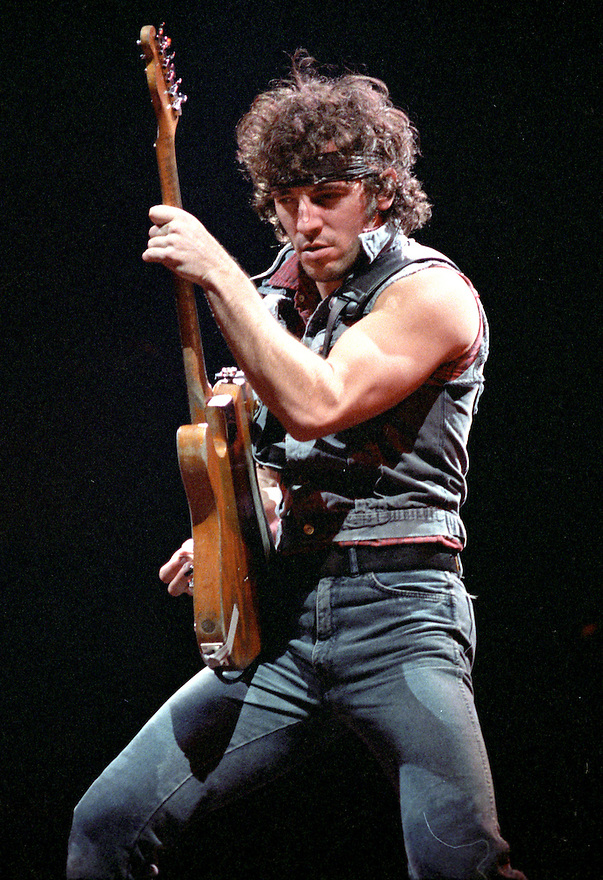
Stepping in at #4 on our list of Top 10 Telecaster Players at GAK is none other than “The Boss” – Bruce Springsteen. Known for his powerful vocals, gripping narratives, and expansive live performances, Springsteen is also an accomplished guitarist.
The guitar most associated with Bruce Springsteen is a 1950s Esquire and Telecaster hybrid. Anyone who’s seen or heard Springsteen or his music would have experienced this true workhorse of a guitar.
Known as the “Mutt”, this Tele can be seen on covers of Greetings From Asbury Park, Born to Run, Live 1975-1985 and Wrecking Ball with its transparent butterscotch blonde finish and stark black pickguard.
This guitar, despite its seemingly understated appearance, has become one of the most iconic instruments in rock history.
A Chance Encounter
After signing with Columbia Records in the early ’70s, a trip to Phil Petillo’s New Jersey guitar shop changed the course of Bruce’s musical career. His goal was to swap out his Gibson Les Paul for a guitar that suited the emerging E-Street Band sound that he was cultivating at the time.
There, he discovered a unique instrument: a Telecaster body with an Esquire neck, a model believed to be from ’53 or ’54. He’d purchase it for only $185, calling it “the best deal of [his] life”.
Bruce’s appreciation for the Telecaster emerged from his admiration for greats like James Burton, Steve Cropper, Jeff Beck and Pete Townshend, not to mention its versatility for soul music — a direction Bruce felt naturally drawn to.
“It was a versatile instrument. I was playing something that was tilting more to soul music, and so I wanted a guitar that could handle the funk and that feeling”.
Unusual Origins
This guitar was unusual in that it was previously modified for session work. Allegedly, it was rigged with four pickups, each with its own output. This allowed session guitarists to record a take through four amps at once, allowing them to earn four times as much for one performance.
When Springsteen encountered this Esquire and Telecaster hybrid, it had these extra electronics removed. However, the routing for all the wiring was still present. This resulted in the guitar being very light, a huge advantage for The Boss’ legendary live shows, and having more acoustic resonance.
The modifications didn’t stop there. Over the years, Phil Petillo added his own tweaks, including hot-wound single-coil pickups and his patented triangular Precision Frets.
Petillo also fitted the guitar with stainless steel and titanium hardware and silicon gaskets. The aim was to make Bruce Springsteen’s guitar effectively waterproof, as it had to endure many sweat-soaked live sets over the years. According to Petillo, “You could play it underwater”.
More Than a Mutt
This modified Fender Telecaster, which Springsteen lovingly refers to as a “1950s mutt”, has not only been the stalwart of his live performances and recordings but has also graced the covers of his iconic albums, including the multi-platinum Born to Run.
It’s the guitar The Boss feels is part of him — a seamless extension of his body and soul.
While Springsteen has held many guitars over the years, he always returns to his tried-and-true Telecaster. Today, he plays replicas on stage which have been modified to emulate the look and feel of the original. Although it was retired from the stage in 2005, the original is still used in the studio.
And for monumental occasions, like the Super Bowl XLIII halftime show, the original makes a triumphant return.
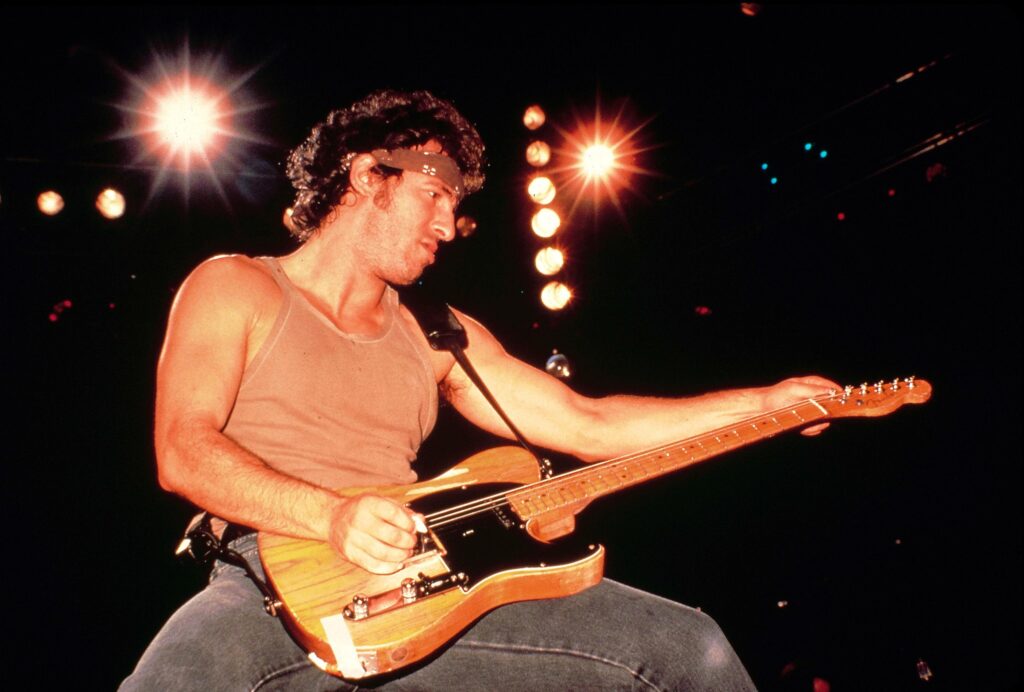
Serving the Song
Springsteen’s playing style is emblematic of his character — robust, dramatic, yet precise and always in the service of the song.
While Bruce might take a step back to let the E Street Band shine — like Roy Bittan’s piano or Clarence Clemons’ sax — the Boss knows how to pull off an exciting solo. As he once expressed, his Tele doesn’t feel like a guitar but an inherent part of him, a symbol of the unyielding spirit of rock and roll.
The Journey Continues
Although retired from road duty, Bruce’s Esquire lives on. The symbiotic relationship between Bruce and this guitar is a testament to the enduring legacy of the Telecaster and its significant role in rock history. As Springsteen himself puts it, the guitar represents the “power of rock and roll and the power of us.”
When The Boss triumphantly raised that Telecaster to an audience at the end of a show, it was a salute to the enduring spirit of music and its ability to touch souls across generations.
Jump Back to the Start
#3 – Danny Gatton
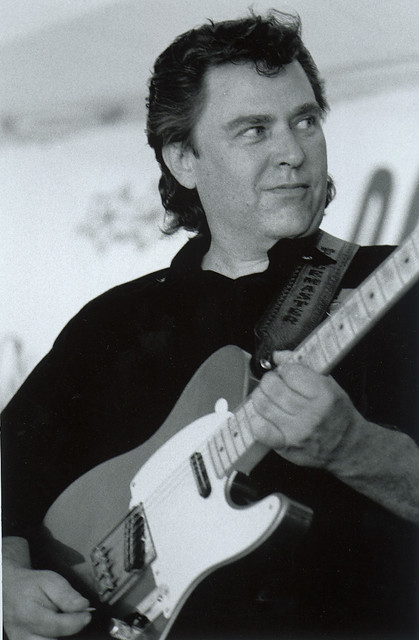
Occupying our #3 slot is the enigmatic genius, Danny Gatton. Bestowed with nicknames like “The Humbler” and “the Telemaster”, Danny’s prowess on the Telecaster was nothing short of legendary.
While he mastered multiple genres – from jazz and blues to country and rockabilly – his playful onstage antics, often involving beer bottles, showcased his whimsical approach to music.
A True Prodigy
Hailing from Washington, D.C., Daniel Wood Gatton Jr. began his love affair with the guitar at age nine. Guided by inspirations like Les Paul and Hank Garland, Gatton fused blues, rockabilly, and country into what he endearingly dubbed “redneck jazz”.
The Telecaster became an extension of his musical genius, with Danny playing the same model from 1953, just like his peer Roy Buchanan.
Their paths would cross frequently in Washington DC, where Danny, ever the eager learner, would watch Buchanan, hoping to glean wisdom from the older guitarist’s performances.
By the ’60s, Gatton was making waves in Nashville, collaborating with big names. Known for his eclectic style, Gatton’s versatility was reflected in his own words when he referred to himself as “a Whitman sampler of music.”
The “Telemaster” Legacy
Heralded as “the world’s greatest unknown guitarist”, a title he shared with Buchanan, Gatton’s finesse with the Telecaster never ceased to impress anyone who was lucky enough to watch him perform.
Both Gatton and Buchanan, despite being masterful guitarists, had a strained relationship with fame and tragically departed from the world early.
Yet, Gatton’s individuality shone brightly. He was a genre-blender, infamously stating, “I can’t stand a whole night of one thing.” His refusal to be boxed into one style made him a tough sell in the music industry but only increased his posthumous reputation.
Beyond Showmanship
Danny’s theatricality, such as playing slide guitar using a beer bottle, was undeniably impressive. However, underneath this showmanship lay a musician of astonishing depth and versatility.
Evidence of this lies in his electrifying performance during his 1991 Austin City Limits appearance where, after using a full beer bottle as a slide, he playfully wiped away the spilt beer with a towel – while continuing to play!
Gatton’s musical restlessness was both his strength and his challenge. He once confessed, “I can’t stand a whole night of one thing; it drives me crazy. I can’t even stand a set of one thing.”
This inexhaustible passion for diverse genres sometimes clashed with the rigid categorizations of the music industry. However, Gatton’s genre-hopping only added more colours to his vivid tapestry of music.
An Undying Legacy
The tragic circumstances of Gatton’s death in 1994, at the age of 49, cast a shadow over a luminous career. Yet, even in his absence, Danny Gatton’s influence on the world of guitar playing remains indomitable.
Guitar legend Steve Vai once remarked, “Danny Gatton comes closer than anyone else to being the best guitar player that ever lived.”
For those unfamiliar with Gatton’s musical journey, albums like 1991’s “88 Elmira St.” and “Unfinished Business” from 1987 offers a mesmerizing introduction. Dive into the world of Danny Gatton, and you’ll discover why he remains an irreplaceable figure in the pantheon of Telecaster Maestros.
Jump Back to the Start
#2 – Keith Richards
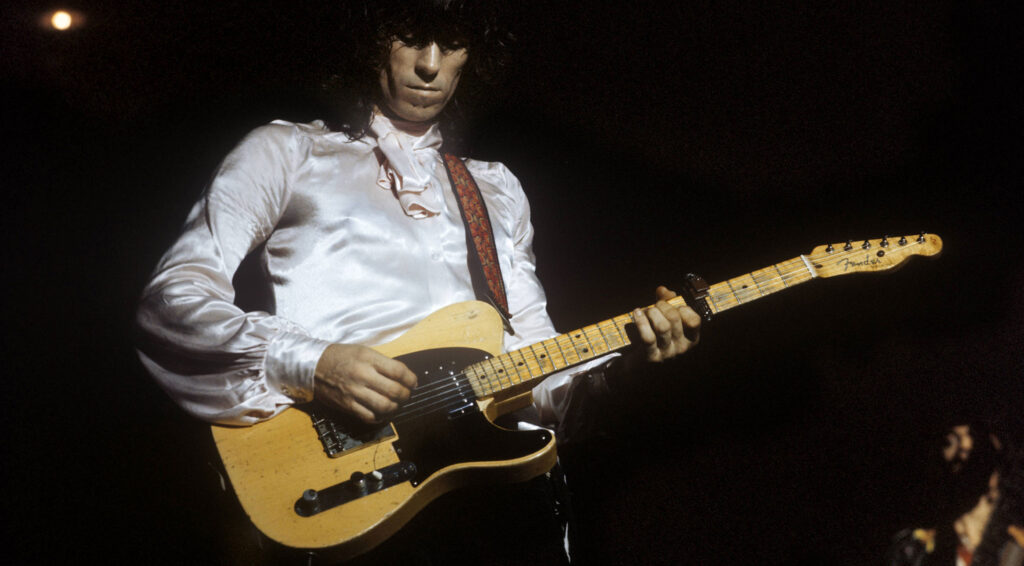
Often dubbed the eternal heartbeat of the Rolling Stones, Keith Richards secures the #2 spot on our list of the Top 10 Telecaster Players at GAK.
Known for his rock-solid rhythm work, catchy riffs, and indomitable spirit, “The Human Riff” embodies the raw essence of rock and roll. With the Telecaster as his weapon of choice, he’s created some of the most enduring and influential music in rock history.
Keith’s Roots and Rise
Born on December 18, 1943, in Dartford, Kent, England, Keith Richards displayed an early affinity for music. His maternal grandfather, Gustav Augustus Dupree, whom Keith often fondly recalled, played a pivotal role in kindling this passion.
The young Richards would listen to Gus play the guitar, and it was under his tutelage that Keith first began to strum.
As a child, Richards was also deeply influenced by the music his mother played, encompassing a wide range of genres from Billie Holiday to Mozart.
It was during his formative years at Wentworth Primary School that he crossed paths with a young Mick Jagger, sharing an infectious enthusiasm for American R&B, and later, rekindling their friendship and mutual musical interests during their teens.
This chance reconnection would mark the inception of a musical partnership that changed the course of rock history.
Developing His Style
Born out of a profound admiration for Elvis’ guitarist Scotty Moore and the guitar virtuosity of Chuck Berry, Richards developed a style deeply entrenched in R&B and old-school blues.
Over the years, his preferences matured, drawing inspiration from legends like Muddy Waters, Hubert Sumlin, and Jimmy Reed.
This bluesman at heart once famously said, “Fuck the rock, it’s all about the roll, baby…” showcasing his unwavering dedication to the fundamental ethos of rock and roll.
Richards’ approach to the guitar, shunning the conventional roles of ‘lead’ and ‘rhythm’ player, set him apart. The Telecaster became his canvas for many timeless Rolling Stones tracks.
Think “Before They Make Me Run,” “Brown Sugar,” and “Honky Tonk Women.” Behind many of these iconic tracks was the legendary Telecaster named “Micawber.”
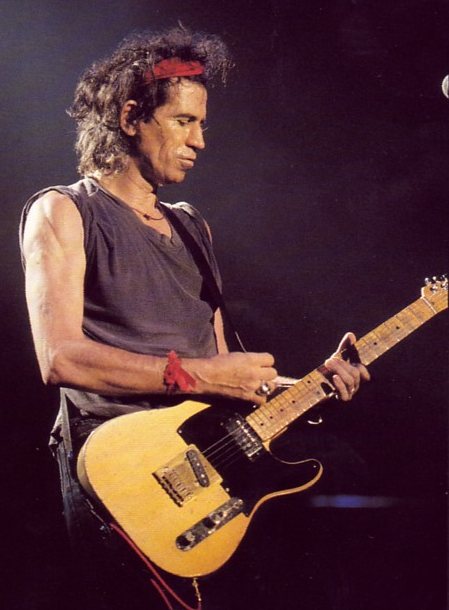
Micawber: A Telecaster Tale
Gifted to Richards by Eric Clapton on his 27th birthday during the “Exile on Main Street” era, Micawber began as a butterscotch-finished 1953 blackguard. Over time, Richards infused his soul into the guitar, making modifications that suited his unique style.
This included installing a Gibson PAF humbucker at the neck but flipped, so the magnet poles faced the tail end, and as the legend goes, a Fender pedal steel pickup at the bridge. Micawber’s storied past is visible in the worn fretboard on the bass side – a testament to Richards’ relentless passion for the instrument.
Apart from Micawber, Keith’s arsenal includes other notable Telecasters like Malcolm, set up identically to Micawber, and a 1967 sunburst named Sonny.
Each guitar resonates with tales of concerts, albums, and the magic of the Stones. Yet, as Keith would put it, it’s not about the guitar’s legacy but the music it aids in creating, saying, “You’re thinking about the track.”
An Icon and His Instrument
Keith Richards’ legendary journey with the Telecaster underscores the guitar’s resilience, versatility, and timeless sound.
While his numerous guitars have their own tales, it’s his synergy with them that birthed some of rock’s most iconic riffs. In the world of Telecaster maestros, Keith Richards remains a force, proving that the right Tele can become an extension of one’s very soul.
Jump Back to the Start
#1 – Jonny Greenwood
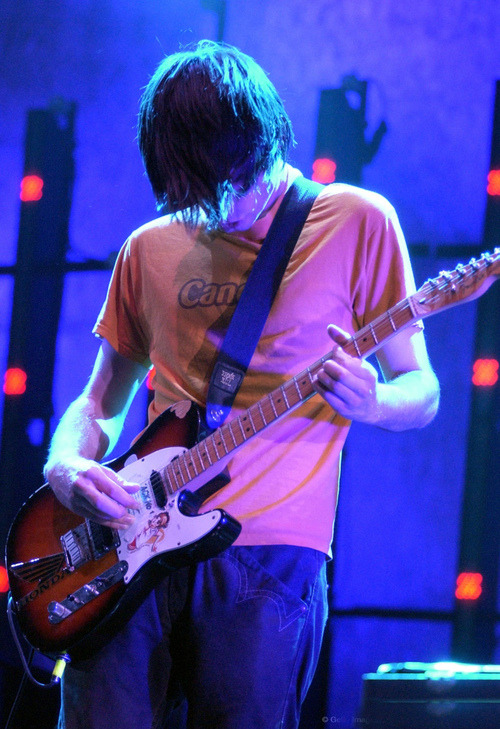
At #1 on our list of Top 10 Telecaster Players at GAK is guitarist, songwriter and composer Jonny Greenwood. Renowned as the lead guitarist and keyboardist for the groundbreaking band Radiohead, Jonny Greenwood is hailed for his innovative playing techniques and sonic textures.
His weapon of choice? A heavily modified 90s Fender Telecaster Plus. This guitar is closely associated with Greenwood, having featured heavily on the incredible Radiohead album OK Computer and beyond.
Greenwood’s versatility, encompassing roles from guitarist to composer, has constantly challenged and expanded the realm of conventional music. His profound fondness for instruments like the Ondes Martenot, as well as his recent dedication to compositional work, signals his unceasing evolution as an artist.
Melding the classic and contemporary seamlessly, Greenwood’s musical journey with Radiohead and as a solo artist is a masterclass in originality.
Recorder to Radiohead
Jonny’s musical journey began far from the world of rock. Immersed in the sounds of Renaissance and Baroque music, young Greenwood played in recorder groups and later became a viola player in the Thames Vale Youth Orchestra.
Joining Radiohead in 1985, originally as a keyboard player, he transitioned to the lead guitarist role and quickly became known for his unique approach to the instrument, both in terms of technique and the sounds he could extract from it.
With Radiohead, Greenwood has been a part of creating some of the most critically acclaimed albums of the modern rock era, including OK Computer, Kid A and In Rainbows.
An Unorthodox Approach
His avant-garde approach to guitar, often using it more as a sound generator than a traditional instrument, has redefined rock guitar playing.
In Radiohead’s early days, Greenwood’s distinctive style resonated through the intense, grunge-inspired approach on albums like Pablo Honey and The Bends.
However, this relentless playing led to physical challenges, prompting Greenwood to adapt and find a balance between ferocity and finesse.
His guitar technique showcases a spectrum of emotions. On one end, there are fierce riffs in songs like “Paranoid Android” and “The Bends”. On the other, Greenwood can conjure serene, gentle textures in the songs like “Weird Fishes/Arpeggi” and “Nude” from In Rainbows.
This juxtaposition of aggression and gentleness, of power and vulnerability, is what makes Jonny’s style so captivating.
He’s credited with bringing experimental soundscapes into mainstream rock, influencing countless musicians in the process. Beyond Radiohead, Greenwood has also made significant contributions as a composer for film, including his score for the acclaimed film There Will Be Blood.
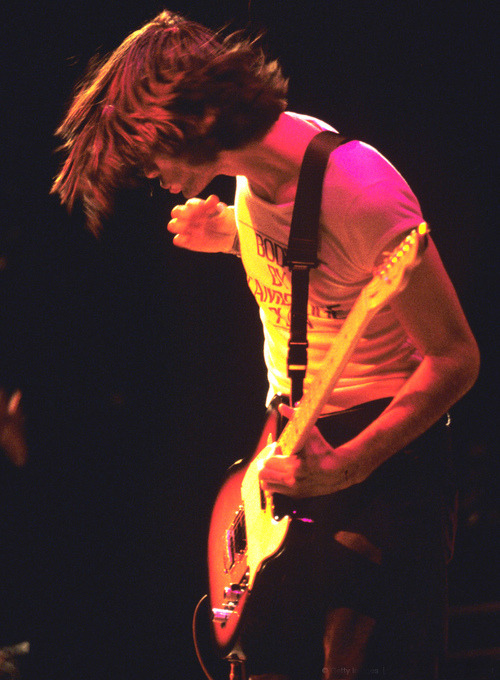
Heavy Modifications
Any Radiohead or Jonny Greenwood fan will be instantly familiar with his tobacco-burst Fender Telecaster Plus. Greenwood’s particular model was built in the early 90s and purchased in late 1995 after his last Telecaster Plus was stolen. It was quickly modified and re-wired to match the stolen guitar.
The intricate re-wiring included an Apem 300 series push-button killswitch, allowing him to mute his volume temporarily. This replaced the original coil-split feature on his Telecaster Plus. Radiohead’s performance of “Airbag” on Jools Holland is a great showcase for how Greenwood uses this feature.
His Tele is also equipped with stock Fender Lace Sensor pickups. The Lace Sensor Blue pickup in the neck is a single-coil-sized humbucker with a warm, 50s-style tone. The “Dually” pickup in the bridge is two Lace Sensor Red pickups screwed together. It offers a fat, punchy humbucking tone.
Interestingly, the small round metal piece on the instrument between the right-side neck pickup screw and one of the pickguard screws is a guitar string’s ball end. Added in 1997, it’s a unique modification that lets Jonny hook his high E-string for very high notes.
Visual modifications include various stickers, like the one from the Anime “Attack No. 1” on the pickguard and a Honda Motorcycles sticker below the bridge.
Serving the Song
It’s not just the Fender Telecaster or even the guitar as a whole that defines Jonny Greenwood. His genius lies in how he uses these instruments to craft soundscapes, push boundaries, and serve the song.
In an industry replete with shredders and virtuosos, Greenwood stands out by consistently prioritizing artistry over ego, the song over the solo.
His place on our list of Top 10 Telecaster Players at GAK is well-deserved, capturing the essence of a musician who continually surprises, challenges, and mesmerizes us.
Jump Back to the Start
Closing Thoughts
And there we have it – a remarkable journey through the annals of guitar history, celebrating ten of the most iconic Telecaster maestros. Each musician, with their trusty Tele in hand, has showcased the astounding range and capability of this legendary guitar.
From the unmistakable twang of country to the raw power of rock, and even the surprising ferocity of metal, the Telecaster has proven time and again its chameleonic versatility.
These artists, each with their distinct stories and sounds, have not only embraced the Telecaster’s unique qualities but have also contributed to its legacy.
Be it Jeff Buckley’s poignant strums on his “Hallelujah” Telecaster, Keith Richard’s powerful riffs with “Macawber”, or Jonny Greenwood’s genre-defying artistry with his mid-nineties Telecaster Plus, each story adds a chapter to the Telecaster’s storied history.
The Telecaster guitar, born from a vision of accessibility, reliability, and versatility, remains a testament to enduring design. It’s more than an electric guitar; it’s a cultural icon.
As we’ve delved into the worlds of these ten guitarists, it’s evident that the Telecaster’s tale is interwoven with the fabric of music itself.
Here at GAK, we hope this exploration has ignited a newfound appreciation for the Telecaster and the exceptional artists who’ve harnessed its potential. Click here to shop Fender and Squier Telecasters at GAK and start your personal Tele journey today.